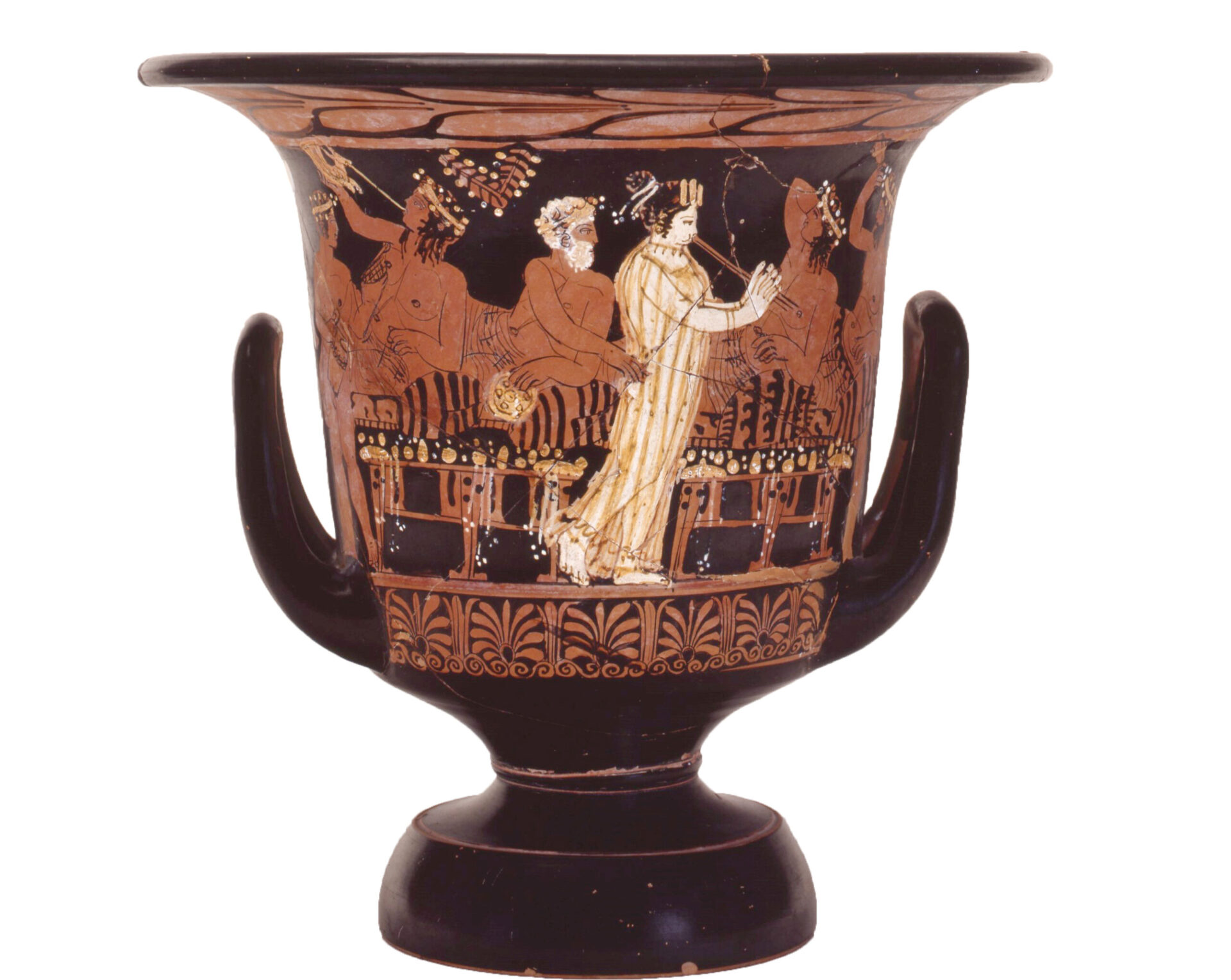Exhibit of the month
The krater of companionship
Attic red-figure calyx krater
By the Uppsala Painter
National Archaeological Museum
Vase Collection, inv. Number A 11559
Provenance: Unknown
Dimensions: Height 0.30m, rim diam. 0.317m, base diam 0.15m.
Date: 400-375 BCE
Display: Vase Collection, Room 55, Showcase 117.
A company of reclining[1] men, with sympotic-ritual objects in hand, namely rhyton and phiale, enjoys the wine offered by the naked oinochoos (cupbearer)[2], a young boy (παῑς), the prettiest among the most beautiful slaves. The men are incrossed in the music of the young flute-girl[3], whom the elder banqueter and presumably host of the evening -since he is portrayed in the middle of the scene- touches erotically. The companions exorcise the headache from wine drinking wearing wreaths of leaves and flowers of specific plants, a custom introduced from the religious festivals of Ionia (Asia Minor). In front of them are placed tables filled with a variety of viands, equal in number, in a statement of parity, which forms the social basis of the symposium.
The representation of the krater narrates the main part of a symposium -wine drinking and discussions among those present, teasing and fun- that comes after the completion of the meal. The introduction to the sympotic process is marked by a libation, according to the testimonies of literary sources. Organizing a banquet was a costly affair, albeit the small circle of participants, while, despite the cheerfulness of the guests, it adhered to a protocol as well as regulations laid down each time by the elected leader, such as the number of wine kraters to be consumed but also the ratio of wine and water. The banquet started early in the evening and its duration was proportional to its success.
The krater[4] illustrates a harmonious gathering, which does not exceed the bounds of decency. Besides, the awareness of the suffering excessive drinking can cause is well established in the common consciousness. It is early taught at the very beginning of the ancient Greek mythology, in Homer, through the blinding of Polyphemus and the indecent behavior of the Centaurus. Moreover, apart from the custom of inviting entertainers, among them women musicians, to accompany men, a loan from the banquets of Ionia since the 7th cent. BCE -in imitation of the banquets of the Lydians- the banqueters were obliged to participate with speeches and music in the company. Thus, the banquet[5] was the cradle of lyric poetry, since there a “poet” recited his verses. The gathering reference point was the krater, which as a holly grail transubstantiated water and wine into relationships of affection, respect, admiration and companionship.
[1] A hint about the custom of reclining during banquets is first made in a 7th cent. BCE literary text (Alcman (Frag. 19 [Athenaeus, 111a]), a posture that until then was attributed to gods or demigods, such as Dionysus, Hermes and Hercules. As early as the beginning of the 6th cent. BCE the custom of reclining during celebrations is attested in the iconography.
[2] The archetypal cupbearer is Ganymede, a teenager notorious for his beauty, who was transferred to Olympus to pour wine at the banquets to the gods and gained immortality and eternal youth in return.
[3] Barbitos, flutes and rattles are associated with the banquet, where in earlier times music was usually performed by the guests themselves, demonstrating their education and cultivation. In fact, Themistocles, of humble origin, was embarassed at a banquet when he failed to respond to the standards of recitation and music.
[4] The use of kraters of different dimensions, for the mixing of wine with water, is already mentioned in Homeric poems, in fact, the content in water was less in cases where the host wanted to entertain a friend (Homer Iliad 9.200-205 ff).
[5] At the same time, the participants in a symposium took the floor, one after the other, presenting their views on a topic that had been jointly decided. The scientific “symposia” of present day, national and international congresses, are a resonance of the ancient Greek symposia.
Dr. Ε. Oikonomou
Indicative bibliography:
M. Tiverios, Συμπόσιο και συμποσιακό τελετουργικό στην Αρχαία Αθήνα, Thessaloniki 2020.
K. Toppe, The imagery of the Athenian Symposium, Cambridge University Press, 2012.
A. Goulaki-Voutyra, Μύθος και πραγματικότητα στην αρχαία ελληνική μουσική, in Μουσών Δώρα. Μουσικοί και χορευτικοί απόηχοι από την αρχαία Ελλάδα (Ε Ανδρίκου-Α. Γουλάκη-Βουτυρά-Χ. Λαναρά-Ζ. Παπαδοπούλου eds), Athens 2004, pp. 39-45.
P. Schmitt-Pantel, “Sacrificial Meal and Symposion: Two Models of Civic Institutions in the Arcaic City?”, in Sympotica, A symposium on the Symposion (Ο. Murray ed.), Oxford: Clarendon Press, 1999.
S. Kourakou-Dragona, Κρατήρ μεστός Ευφροσύνης, Athens 1998.


